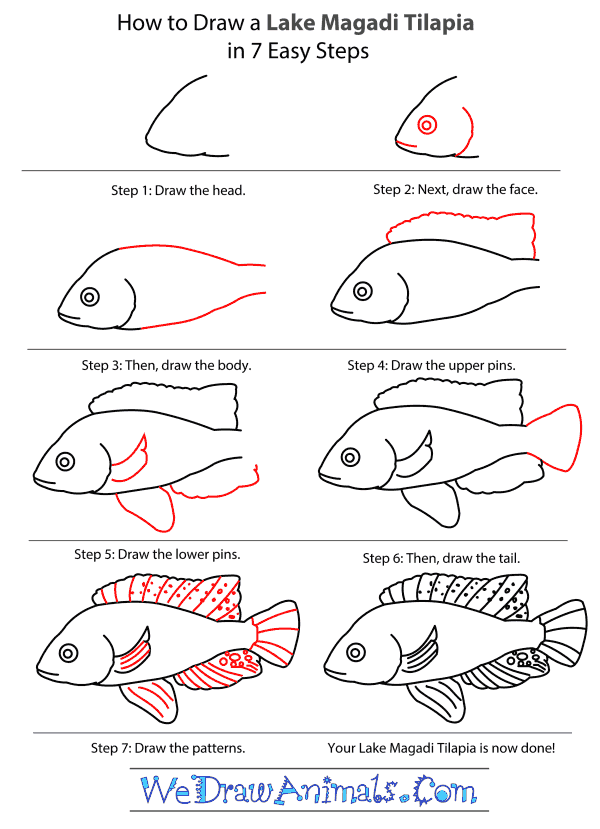In this quick tutorial you'll learn how to draw a Lake Magadi Tilapia in 7 easy steps - great for kids and novice artists.
The images above represent how your finished drawing is going to look and the steps involved.
Below are the individual steps - you can click on each one for a High Resolution printable PDF version.
At the bottom you can read some interesting facts about the Lake Magadi Tilapia.
Make sure you also check out any of the hundreds of drawing tutorials grouped by category.
How to Draw a Lake Magadi Tilapia - Step-by-Step Tutorial
Step 1: Draw a curved, sideways V-shape for a head.
Step 2: Draw a small curve in the point, a circle within a circle in the upper-middle, and a large upward curve from the bottom end.
Step 3: Connect each end of the head to a curved line that stretches outward, then back in, making a vase-like shape.
Step 4: From the back of the top of the head, draw a wavy, angular shape that goes up slightly, bends back over the body, then bends down to meet the rear end.
Step 5: Next to the gill, draw a curve that goes back and upwards, then bends back under itself. At the same point underneath the body, draw a U-shape. Behind this fin, draw a wavy curve that goes from this point to the rear end.
Step 6: In the gap at the rear, draw a curved, triangle-like shape that connects the ends.
Step 7: Draw lines in all of the fins, and add a few small circles in the top and bottom rear fins. You have drawn a Lake Magadi tilapia! You can color it a pale greenish color with darker markings. These fish can survive in very high temperatures, but it makes it hard for them to breathe, and they have to gulp air to help.
Interesting Facts about the LAKE MAGADI TILAPIA
The Lake Magadi Tilapia is a member of the fish group and the scientific term for them is Alcolapia grahami. Their aquatic habitat is in Kenya of Africa and is extremely saturated with saltwater and is very alkaline. Unlike most fish expelling ammonia, this creature only expels urea since the pH level of the lake is so high and therefore prevents the absorption that the other species’ can do.
Did you know?
- This animal was first documented in 1912.
- This species thrives in water that is up to about 100 degrees Fahrenheit.
- The animal survives in water that is up to almost 107 degrees Fahrenheit.
- The intestinal excretion of excess salt from seawater ingestion by most fish is only about 30 percent.
- This species excretes excess salt by more than 70 percent.
Another unique trait of this animal is in how it diffuses nitrogen into the water after eating bacteria that contains a lot of nitrogen. When the water temperature increases to an extreme level, the available oxygen in the water decreases. Simultaneously, the urea amount and the metabolism rate, increase. This extra demand for oxygen in the fish causes them to breach the water’s surface and gasp for air, which satisfies their demand. These animals have a low population amount and are considered to be vulnerable for extinction.








